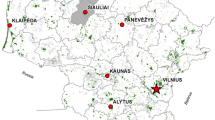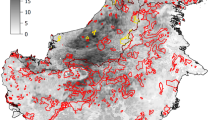Abstract
Habitat loss and fragmentation are principal causes for population declines and the loss of biodiversity across the globe. In the United States, tropical hardwood hammock is a threatened forest ecosystem that occurs only in extreme south Florida, primarily on the Florida Keys archipelago. This rare forest type is characterized by high plant diversity that is strongly influenced by tropical, mast-producing trees and shrubs of West Indian origin. Tropical hardwood hammocks in the Florida Keys provide important habitat for resident and migratory birds, particularly Neotropical species that rely on suitable stopover habitat during migration. The Florida Keys are under intense development pressure, particularly in higher elevation sites where tropical hardwood hammock occurs. With exception of a survey completed during 1991 in the Upper Keys, information regarding habitat loss and current coverage, conservation status, and how best to conserve remaining patches of this rare forest habitat are lacking. We used a Geographic Information Systems approach to assess the extent of loss and fragmentation of tropical hardwood hammock in the upper Keys during 1991–2004, quantify area and number of hammock patches under private ownership and in conservation status throughout the Florida Keys as of 2004, and evaluate strategies to most effectively conserve large blocks of remaining tropical hardwood hammock. Total remaining hammock habitat throughout the Keys encompassed 3,712 ha and hammock habitat declined by 31% in the upper Keys during 1991–2004. Hammock habitat in the upper Keys encompassed 1,962 ha among 124 habitat patches (median = 1.5 ha, range = 0.1–205.7 ha), of which 1,066 ha (54%) were under conservation status. Hammock habitat in the lower Keys encompassed 1,750 ha among 102 patches (median = 4.4 ha, range = 0.3–96.3 ha), of which 1,283 ha (73%) were protected under conservation status. Approximately 37% of total remaining hammock habitat remained unprotected. However, our analyses revealed that many unprotected areas >20 ha were contiguous with protected hammocks. Safeguarding 22 partially protected patches >20 ha (17% of remaining patches) would protect an additional 750 ha of hammock habitat, which represents 55% of all remaining unprotected hammock habitat in the Keys, and would increase the mean patch size of these larger forest patches from 55 to 89 ha. Consequently, strategically focusing conservation efforts on remaining forest patches of tropical hardwood hammock >20 ha in size and contiguous to existing protected areas represents the most effective use of conservation dollars and would provide greater ecological benefits than conservation of small patches of highly fragmented habitat.


Similar content being viewed by others
References
Balmford A, Cowling RM (2006) Fusion or failure? The future of conservation biology. Conserv Biol 20:692–695. doi:10.1111/j.1523-1739.2006.00434.x
Bancroft GT, Strong AM, Carrington M (1995) Deforestation and its effects on forest-nesting birds in the Florida Keys. Conserv Biol 9:835–844. doi:10.1046/j.1523-1739.1995.09040835.x
Bancroft GT, Bowman R, Sawicki RJ (2000) Rainfall, fruiting phenology, and the nesting Season of White-crowned pigeons in the upper Florida Keys. Auk 117:416–426. doi:10.1642/0004-8038(2000)117[0416:RFPATN]2.0.CO;2
Banks RC, Cicero C, Dunn JL, Kratter AW, Rasmussen PC, Remsen JV Jr, Rising JD, Stotz DF (2003) Forty-fourth supplement to the American Ornithologists’ Union check-list of North American birds. Auk 120:923–931. doi:10.1642/0004-8038(2003)120[0923:FSTTAO]2.0.CO;2
Barrow WC Jr, Chen C, Hamilton RB, Ouchley K, Spengler TJ (2000) Disruption and restoration of en route habitat, a case study: the Chenier Plain. Pages 71–87 in Moore, F. R. editor. Stopover ecology of Nearctic-Neotropical landbird migrants: habitat relations and conservation implications. Studies in Avian Biology. Cooper Ornithological Society
Brown RB, Stone EL, Carlisle VW (1990) Soils. In: Myers RL, Ewel JJ (eds) Ecosystems of Florida. University of Central Florida Press, Orlando, Florida, pp 35–69
Caudill J (2003) 2001 national and state economic impacts of wildlife watching: addendum to the 2001 national survey of fishing, hunting and wildlife-associated recreation. Report 2001-2. US Fish and Wildlife Service, Arlington, Virginia
Craighead FC Sr (1971) The trees of south Florida Volume 1: the natural environments and their succession. University of Miami Press, Coral Gables, FL
Fernandez-Juricic E, Jokimaki J (2001) A habitat island approach to conserving birds in urban landscapes: case studies from southern and northern Europe. Biodivers Conserv 10:2023–2043. doi:10.1023/A:1013133308987
Florida Climate Center (2005) The Center for Ocean-Atmospheric Prediction Studies. Florida State University, Tallahassee, FL. Available from http://coaps.fsu.edu/climate_center/ (accessed January 2007)
Florida Department of Environmental Protection (1997) State lands economics of acquisition - excerpt from the Florida Preservation 2000 Program remaining needs and priorities study. Tallahassee, FL. Available from http://www.dep.state.fl.us/lands/acquisition/P2000/ECONOMIC.htm (accessed August 2007).
Florida Department of Community Affairs (2003) Final Report of the Florida Keys Carrying Capacity Study Implementation − Rule 28-20 Work Group. Tallahassee, FL. Available from http://www.dca.state.fl.us/FDCP/DCP/acsc/final.pdf (accessed May 2006)
Florida Department of Environmental Protection (2003) Land Boundary Information System. Tallahassee, FL. Available from http://data.labins.org/2003/ (accessed May 2005)
Florida Department of Transportation (1999) Florida Land Use, Cover and Forms Classification Handbook (3rd ed.). Department of Transportation Surveying and Mapping Geographic Mapping Section, Florida Department of Transportation, Tallahassee, FL, 93 pp. Available from http://www.dot.state.fl.us/surveyingandmapping/Manuals/fluccmanual.pdf (accessed March 2009)
Forman RTT, Alexander LE (1998) Roads and their major ecological effects. Annu Rev Ecol Syst 29:207–231. doi:10.1146/annurev.ecolsys.29.1.207
Forman RTT, Sperling D, Bissonette JA, Clevenger AP, Cutshall CD, Dale VH, Fahrig L, France R, Goldman CR, Heanue K, Jones JA, Swanson FJ, Turrentine T, Winter TC (2003) Road Ecology: Science and Solutions. Island Press, Washington, D.C
Goosem M (1997) Internal Fragmentation: The effects of roads, highways, and powerline clearings on movements and mortality of Rainforest vertebrates. Pages 241 – 255 in W.F. Lawrence and R.O. Bierrgarrd Jr. editors. Tropical Forest Remnants − Ecology, Management, and Conservation of Fragmented Communities. University of Chicago Press. Chicago, IL
Karim A, Main MB (2004) Tropical Hardwood Hammocks in Florida. University of Florida Cooperative Extension Service Document WEC 206.4 pp. University of Florida, UF/IFAS Extension Digital Information Source (EDIS) Database. Available from http://edis.ifas.ufl.edu/UW206 (accessed May 2006)
Karim A (2007) Status and use of tropical hardwood hammocks and forested residential areas as habitat for resident and Neotropical migratory birds in the Florida Keys [Master of Science Thesis]. University of Florida, Gainesville, FL
Kerlinger P (1989) Flight strategies of migrating hawks. University of Chicago Press, Chicago, IL
Keyser AJ, Hill GE, Soehren EC (1998) Effects of forest fragmentation size, nest density, and proximity to edge on the risk of predation to ground-nesting passerine birds. Conserv Biol 12:986–994. doi:10.1046/j.1523-1739.1998.97177.x
Levey DJ, Stiles FG (1992) Evolutionary precursors of long-distance migration: resource availability and movement patterns in neotropical land birds. Am Nat 140:447–476
Lincoln FC, Peterson SR, Zimmerman JL (1998) Migration of birds. U.S. Department of the Interior, U.S. Fish and Wildlife Service, Washington, D.C. Circular 16. Jamestown, ND: Northern Prairie Wildlife Research Center Home Page. Available from http://www.npwrc.usgs.gov/resource/othrdata/migratio/migratio.htm (Version 02APR2002). (accessed September 2004)
Lodge TE (2005) The Everglades handbook−understanding the ecosystem, 2nd edn. CRC Press, Boca Raton, FL
Lopez RR (2001) Population ecology of Florida Key Deer. Ph.D. Dissertation. Texas A & M University, College Station, Texas
Main MB, Roka FM, Noss R (1999) Evaluating costs of conservation. Conserv Biol 13:1262–1272. doi:10.1046/j.1523-1739.1999.98006.x
Main MB, Karim A, Hostetler ME 2003. Conservation Options for Private Landowners in Florida. University of Florida Cooperative Extension Service Circular 1441. 10 pp. University of Florida, UF/IFAS Extension Digital Information Source (EDIS) Database. Available from http://edis.ifas.ufl.edu/UW194 (accessed October 2006)
Maurer BA, Heywood SG (1993) Geographic range fragmentation and abundance in Neotropical migratory birds. Conserv Biol 73:501–509. doi:10.1046/j.1523-1739.1993.07030501.x
Meffe, G. K., C. R. Carroll, and contributors. 1997. Management to meet conservation goals: general principles. Pages 247–383 in G. Meffe and C. Carroll, editors. Principles of conservation biology. 2nd edition. Sinauer Associates, Sunderland, Massachusetts
Moore FR (ed) 2000. Stopover ecology of Nearctic-Neotropical landbird migrants: habitat relations and conservation implications. Studies in Avian Biology. 20: 133 pp. Cooper Ornithological Society
Moore FR, Kerlinger P, Simons TR (1990) Stopover on a Gulf Coast barrier island by spring trans-gulf migrants. Wilson Bull 102:487–500
Morris SR, Holmes DW, Richmond ME (1996) A ten-year study of the stopover patterns of migratory passerines during fall migration on Appledore Island, Maine. Condor 98:395–409. doi:10.2307/1369157
Noss RF, Roet ETIII, Scott JM (1995) Endangered ecosystems of the United States: a preliminary assessment of loss and degradation. Biological Report 28. US Department of the Interior, National Biological Service, Washington D.C
Parrish JD (2000) Behavioral, energetic, and conservation implications of foraging plasticity during migration. Stud Avian Biol 20:53–70
Petit DR 2000. Habitat use by landbirds along Nearctic-Neotropical migration routes: implications for conservation of stopover habitats. Pages 15–33 in F.R. Moore editor. Stopover ecology of Nearctic-Neotropical landbird migrants: habitat relations and conservation implications. Studies in Avian Biology. Cooper Ornithological Society
Reijnen R, Foppen R, Braak CT, Thissen J (1995) The effects of car traffic on breeding bird populations in woodland. III. Reduction of density in relation to the proximity of main roads. J Appl Ecol 32:187–202. doi:10.2307/2404428
Ripple J (1995) The Florida Keys-the natural wonders of an island paradise. Voyageur Press, Stillwater, MN
Russell RW, May ML, Soltesz KL, Fitzpatrick JW (1998) Massive swarm migrations of dragonflies (Odonata) in Eastern North America. Am Midl Nat 140:325–342. doi:10.1674/0003-0031(1998)140[0325:MSMODO]2.0.CO;2
Sauer JR, Droege S 1989. Geographic patterns in population trends of Neotropical migrants in North America. Pages 26–42 in J.M Hagan III and D. W. Johnston editors. 1992. Ecology and conservation of Neotropical migratory landbirds. Manomet Bird Observatory
Schaub M, Jenni L (2001) Variation of fuelling rates among sites, days, and individuals in migrating passerine birds. Funct Ecol 15:584–594. doi:10.1046/j.0269-8463.2001.00568.x
Simons TR, Pearson SM, Moore FR 2000. Application of spatial models to the stopover ecology of trans-gulf migrants. Pages 4–14 in F.R Moore editor. Stopover ecology of Nearctic-Neotropical landbird migrants: habitat relations and conservation implications. Studies in Avian Biology. Cooper Ornithological Society
Smith RJ, Moore FR (2003) Arrival fat and reproductive performance in a long-distance passerine migrant. Oecologica 134:325–331
Snyder JR, Herndon A, Robertson WB Jr (1990) South Florida rocklands. In: RLMyers JJ Ewel (ed) Ecosystems of Florida (pp. 230–277). Florida, University of Central Florida Press, Orlando
Sunquist F, Sunquist M, Beletsky A (2002) The ecotravellers’ wildlife guide to Florida. Natural World Academic Press, San Diego, CA
Terbough J (1989) Where have all the birds gone?. Princeton University Press, Princeton, NJ
United States Census Bureau 1995. Population of Counties by Decennial Census: 1900 to 1990. Washington, D.C. Available online: http://www.census.gov/population/cencounts/fl190090.txt (accessed August 2006)
United States Census Bureau 2000. Washington, D.C. Population of Monroe County. Available online: http://www.census.gov/qfd/states/12/12087.html (accessed May 2008)
United States Fish and Wildlife Service 1999. South Florida multi-species recovery plan. USFWS Southeast Region, Compact Disk. Available online: http://www.fws.gov/verobeach/index.cfm?Method=programs&NavProgramCategoryID=3&programID=107&ProgramCategoryID=3 (accessed August 2006)
Waitley D (1997) Roadside history of Florida. Mountain Press Publishing Company, Missoula, MT
Wilcox BA, Murphy DD (1985) Conservation strategy: the effects of fragmentation on extinction. Am Nat 125:879–887. doi:10.1086/284386
Wilson EO (1992) The diversity of life. Harvard University Press, New York, NY
Ydenberg, R.C., R.W. Butler, D.B. Lank, C.G. Guglielmo, M. Lemon, and N. Wolf. 2002. Trade-offs, condition dependence and stopover site selection by migrating
Acknowledgements
We thank the city of Islamorada, the Village of Islands for contributing funding to support this project. We also thank the University of Florida Institute of Food and Agricultural Sciences, Southwest Florida Research and Education Center for providing a research assistantship and the Keys Marine Laboratory for lodging.
Author information
Authors and Affiliations
Corresponding author
Rights and permissions
About this article
Cite this article
Karim, A., Main, M.B. Habitat fragmentation and conservation strategies for a rare forest habitat in the Florida Keys archipelago. Urban Ecosyst 12, 359–370 (2009). https://doi.org/10.1007/s11252-009-0089-8
Published:
Issue Date:
DOI: https://doi.org/10.1007/s11252-009-0089-8




